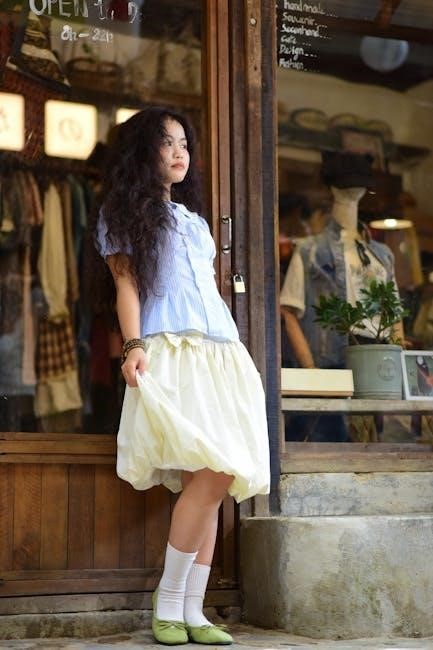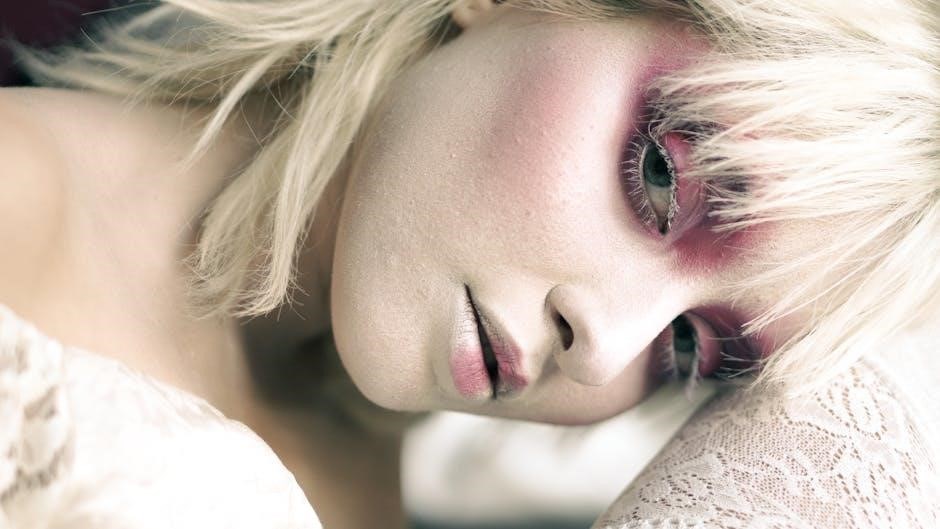
The Hair and Beauty Industry Award governs wages, conditions, and entitlements for employees in the sector. It ensures fair compensation and compliance with workplace standards, benefiting both employers and employees.
1.1 Overview of the Award Structure
The Hair and Beauty Industry Award is structured to classify employees into distinct levels based on experience and responsibilities. It outlines minimum pay rates, working conditions, and entitlements for hairdressers, beauticians, and other roles. The award ensures compliance with workplace standards and provides a framework for fair compensation. Employees are categorized into levels, with corresponding pay scales, to reflect their skills and expertise. This structure promotes transparency and consistency across the industry, ensuring all workers receive appropriate remuneration for their contributions.
1.2 Importance of the Pay Guide in the Industry
The pay guide is essential for ensuring fair and consistent compensation across the hair and beauty industry. It provides clear guidelines for employers to adhere to legal obligations, avoiding underpayment issues. Employees benefit from transparent pay structures, reflecting their skills and experience. The guide also outlines entitlements like allowances and overtime, ensuring compliance with workplace laws. Regular updates keep the guide aligned with industry standards, fostering trust and fairness between employers and staff. This resource is vital for maintaining a balanced and equitable work environment in the sector.

Current Pay Rates for Hair and Beauty Employees
Current pay rates for hair and beauty employees vary by level, with Level 1 at $974.80, Level 2 at $997.10, and Level 3 at $1032.30. Rates apply from the first full pay period on or after 1 July 2025.
2.1 Hair and Beauty Employee Level 1 Pay Rates
Hair and beauty employee Level 1 pay rates are set at $974.80 per week, or $25.65 per hour. These rates apply to entry-level positions, such as salon assistants or junior staff, who perform basic tasks under supervision. The rates are effective from the first full pay period on or after 1 July 2025. Level 1 employees typically support senior staff, assist with client services, and maintain salon hygiene. Employers must ensure compliance with these rates to meet the requirements of the Hair and Beauty Industry Award.
2.2 Hair and Beauty Employee Level 2 Pay Rates
Hair and beauty employee Level 2 pay rates are set at $997.10 per week, or $26.24 per hour. These rates apply to employees with basic skills in tasks like hair cutting, coloring, or styling. They work under limited supervision and may perform routine client services. The rates are effective from the first full pay period on or after 1 July 2025. Level 2 roles require some experience and are crucial for salons, ensuring quality services while adhering to industry standards and employer obligations under the Hair and Beauty Industry Award.
2.3 Hair and Beauty Employee Level 3 Pay Rates
Hair and beauty employee Level 3 pay rates are $1,032.30 per week, or $27.30 per hour. These rates apply to employees with advanced skills in specialized tasks like advanced hair cutting, coloring, or complex styling. Level 3 roles require independent decision-making and the ability to manage multiple tasks; The rates are effective from the first full pay period on or after 1 July 2025. This level reflects higher expertise, ensuring premium service delivery in salons and compliance with industry standards under the Hair and Beauty Industry Award.
Apprentice Pay Rates and Conditions
Apprentice pay rates vary based on experience and training level, with junior apprentices earning 80% of the adult rate and adult apprentices receiving higher rates as they progress.
3.1 Junior Apprentice Pay Rates

Junior apprentice pay rates are structured to reflect their training progression. Apprentices typically earn 80% of the adult rate in their first year, increasing incrementally. Rates are adjusted annually, ensuring fair compensation as skills develop. Employers must adhere to these scales to comply with the Hair and Beauty Industry Award. Pay guides are updated each July, so staying informed is crucial for accurate wage calculations. These rates support apprentices in gaining experience while ensuring employers meet legal obligations. Always consult the latest pay guide for current figures.
3.2 Adult Apprentice Pay Rates
Adult apprentice pay rates are determined by their level of experience and progression. Typically, adult apprentices earn 80% of the adult rate in their first year, with incremental increases. These rates are adjusted annually to reflect industry standards. Employers must comply with the specified scales to ensure fairness and legality. Adult apprentices often bring prior skills, which can influence their starting pay. Staying updated with the latest pay guide is essential for accurate wage calculations and compliance with the Hair and Beauty Industry Award requirements.
3.3 Key Conditions for Apprentices
Key conditions for apprentices include structured training, mentorship, and adherence to workplace standards. Apprentices must receive regular progress reviews and fair compensation as per the award. Employers are obligated to provide a safe environment and necessary tools. Apprentices are entitled to leave entitlements, including annual and sick leave. Proper record-keeping of hours, training, and pay is essential. These conditions ensure apprentices receive adequate support and development opportunities while complying with industry regulations. Employers must also ensure apprentices are not subjected to unfair treatment or exploitation.

Working Hours and Overtime
The Hair and Beauty Industry Award sets standard working hours and overtime rates. Employees typically work 38 hours per week, with overtime paid at higher rates. Rates are adjusted annually from 1 July, ensuring fair compensation for all workers.
4.1 Standard Working Hours in the Industry
Standard working hours for hair and beauty employees are typically 38 hours per week, divided into shifts. These may include weekdays and weekends, depending on salon demands. Employees are entitled to regular breaks, ensuring compliance with workplace standards. Employers must adhere to these guidelines to maintain fair labor practices and avoid penalties. The Award outlines clear expectations for both full-time and part-time employees, promoting a balanced work environment.
4.2 Overtime Rates and Calculations
Overtime rates for hair and beauty employees are detailed in the Award, ensuring fair compensation for extended hours. Overtime is typically paid at 1.5 times the standard rate for the first two hours on Saturdays and double time thereafter. Sundays and public holidays attract double time for all hours worked. These rates apply to both full-time and casual employees, promoting transparency and compliance with workplace standards. Accurate calculation of overtime is crucial to avoid underpayment and ensure adherence to the Hair and Beauty Industry Award guidelines.
Allowances and Additional Payments
The Hair and Beauty Industry Award includes provisions for allowances to cover tools, uniforms, and laundry. These payments ensure employees are reimbursed for work-related expenses, maintaining equity.
5.1 Tool Allowances for Hair and Beauty Professionals
Hair and beauty professionals are entitled to tool allowances to cover the cost of maintaining their equipment. Full-time employees receive a weekly tool allowance of $25.65, while part-time or casual workers receive $5.32 per shift. These payments are designed to reimburse professionals for the upkeep and replacement of tools essential to their work, ensuring they can maintain high standards of service without additional financial burden. The allowance is paid in addition to their regular wages, reflecting the industry’s recognition of the importance of professional tools.
5.2 Uniform and Laundry Allowances
Hair and beauty professionals are entitled to uniform and laundry allowances to cover the cost of maintaining work attire. Full-time employees receive a weekly allowance of $15.20, while part-time or casual workers receive $3.04 per shift. These payments are designed to reimburse employees for the cost of cleaning and maintaining uniforms, ensuring they can present a professional image. The allowance is paid in addition to regular wages and is a key component of the industry’s compensation structure. Employers must ensure these payments are made consistently to comply with the award.

Leave Entitlements
Employees are entitled to annual leave, sick leave, and bereavement leave. Annual leave includes four weeks per year and a 17.5% annual leave loading. Sick leave is unlimited but requires medical certification, while bereavement leave provides up to two days for family matters.
6.1 Annual Leave and Loading
Employees in the hair and beauty industry are entitled to four weeks of annual leave per year. Additionally, they receive a 17.5% annual leave loading, calculated based on their regular pay rate. This loading is paid either before the leave commences or at the employer’s discretion. The leave entitlements are designed to provide employees with adequate rest and relaxation, ensuring they return to work refreshed. Annual leave loading is a key component of the Hair and Beauty Industry Award, reflecting the industry’s commitment to fair compensation and work-life balance.
6.2 Sick Leave and Bereavement Leave
Employees in the hair and beauty industry are entitled to paid sick leave and bereavement leave. Sick leave provides up to 10 days per year for personal illness or injury, while bereavement leave offers 2-3 days for immediate family matters. These entitlements ensure employees can address personal health and family needs without financial hardship. The leave is paid at the employee’s regular rate, supporting work-life balance and overall well-being. These provisions are essential for maintaining a healthy and productive workforce within the industry.

Compliance and Record-Keeping
Employers must adhere to the Hair and Beauty Industry Award, ensuring accurate payroll records, correct wage payments, and compliance with all regulations to avoid penalties.
7.1 Employer Obligations Under the Award
Employers in the hair and beauty industry must comply with the award by paying correct wages, maintaining accurate payroll records, and ensuring all conditions are met. Key obligations include providing payslips, adhering to working hours, and meeting health and safety standards. Employers must also ensure employees receive entitlements like annual leave, sick leave, and public holiday pay. Non-compliance can result in penalties, emphasizing the importance of understanding and adhering to the award’s requirements to maintain a fair and lawful workplace environment.
7.2 Importance of Accurate Payroll Records

Accurate payroll records are crucial for compliance with the Hair and Beauty Industry Award. They ensure employees receive correct payments, including wages, allowances, and entitlements. Employers must maintain detailed records of hours worked, pay rates, and leave balances. This documentation is essential for audits, disputes, and demonstrating compliance with legal obligations. Inaccurate records can lead to penalties and reputational damage. Employers must prioritize transparency and precision in payroll management to build trust with employees and avoid legal complications.
Industry Trends and Salary Projections
The hair and beauty industry is projected to grow significantly, with salaries increasing due to inflation and rising demand for specialized services, enhancing career opportunities.

8.1 Growth of the Hair and Beauty Industry
The hair and beauty industry is experiencing significant growth, driven by increasing demand for specialized services and premium products. The sector is expected to reach a valuation of $6.5 billion, reflecting rising consumer interest in grooming and aesthetics. Factors such as technological advancements, evolving trends, and a focus on sustainability are fueling this expansion. Additionally, the proliferation of social media has heightened awareness of hairstyling and beauty treatments, further boosting the industry’s trajectory. This growth is creating new opportunities for professionals and businesses alike.
8.2 Emerging Trends in Hair and Beauty Salaries
Salaries in the hair and beauty industry are evolving due to skill demand and market competition. Higher pay rates for senior roles reflect expertise value, while apprentices see structured wage growth. Casual and part-time workers benefit from increased flexibility and hourly rates. Employers are prioritizing transparent pay structures to attract talent. These trends highlight a shift toward rewarding experience and specialization, ensuring fairness and motivating professionals to grow within the industry. This alignment with market demands supports long-term sustainability and employee satisfaction.
Salon-Specific Pay Rates
Salon-specific pay rates vary by employment type, with full-time, part-time, and casual rates differing. Full-time employees typically earn a weekly rate, while casuals receive higher hourly pay. These rates ensure compliance with the Hair and Beauty Industry Award and reflect industry standards for fair compensation.
9.1 Full-Time and Part-Time Pay Rates
Full-time employees in the hair and beauty industry are entitled to a weekly pay rate of $1,082.90, while part-time employees receive a proportionate amount based on hours worked. Part-time rates are calculated by dividing the full-time weekly rate by the standard working hours per week. For example, a part-time employee working 20 hours per week would receive 50% of the full-time rate. These rates are outlined in the Hair and Beauty Industry Award and are adjusted annually to reflect industry standards and cost-of-living changes.
9.2 Casual Employee Rates
Casual employees in the hair and beauty industry receive higher rates to compensate for the lack of leave entitlements and other benefits. The casual rate is typically 25% more than the part-time rate. For example, casual employees working on Saturdays between 7 am and 6 pm receive $37.91 per hour, while Sunday rates are $57.00 per hour. These rates apply from the first full pay period on or after specific dates, such as 31 December 2022 or 30 April 2023, ensuring compliance with the Hair and Beauty Industry Award.
Public Holiday and Weekend Rates
Public holiday and weekend rates are higher to compensate for working during these periods. Public holiday rates are $71.25, while Saturday rates are $37.91. These rates apply from the first full pay period on or after specific dates, ensuring compliance with the Hair and Beauty Industry Award.
10.1 Saturday and Sunday Pay Rates
Saturday and Sunday pay rates are higher than standard rates to reflect weekend work. Employees receive $37.91 for Saturday shifts and $57.00 for Sunday shifts. These rates apply from the first full pay period on or after specific dates, ensuring compliance with the Hair and Beauty Industry Award. The rates are designed to compensate employees for working during weekends, aligning with industry standards and employer obligations under the award. This ensures fair compensation for weekend work, promoting workforce stability and satisfaction.
10.2 Public Holiday Pay Rates
Public holiday pay rates are higher to compensate employees for working on designated holidays. The rate is $71.25 per hour, applying from the first full pay period on or after 01 July 2025. This rate reflects the premium for working on public holidays, ensuring fair compensation. Part-time and casual employees are also entitled to this rate, provided they are rostered to work on the holiday. The award ensures consistency in payment for public holidays, maintaining equitable workplace practices across the hair and beauty industry.
Tips for Calculating Pay Correctly
Understand pay periods, ensure accurate overtime calculations, and refer to the latest award rates to avoid errors. Double-check employee classifications for correct pay application.
11.1 Understanding Pay Periods and Cutoffs
Accurate pay calculation begins with understanding pay periods and cutoff dates. Employers must ensure all hours worked within the specified period are included in the correct pay cycle. Pay periods typically run weekly or fortnightly, with cutoffs on specific dates. Missing deadlines can lead to delays in payment, causing dissatisfaction among employees. Using payroll software can streamline this process, ensuring timely and accurate payments; Proper record-keeping is essential to avoid discrepancies and maintain compliance with the Hair and Beauty Industry Award.
11.2 Avoiding Common Pay Calculation Errors
Common pay calculation errors often arise from incorrect application of rates, misclassification of employees, or failure to account for overtime and allowances. To avoid these, employers should regularly review payroll processes and ensure accurate classification of staff. Using payroll software can help automate calculations and reduce human error. Additionally, staying updated on award rate changes and understanding entitlements, such as tool allowances and public holiday rates, is crucial. Employers must also ensure all adjustments are documented and communicated clearly to maintain transparency and compliance with the Hair and Beauty Industry Award.

Hair and Beauty Salon Reviews and Ratings
Hair and beauty salons are reviewed based on service quality, customer satisfaction, and overall experience. Top-rated salons in Dubai International Financial Centre, like Salon Nadeshiko and The Grove Salons, boast high ratings for exceptional service and expertise.
12.1 Top-Rated Salons in Dubai International Financial Centre
Dubai International Financial Centre (DIFC) hosts some of the best salons, blending luxury with expertise. Salon Nadeshiko, known for Japanese hairstyling, and The Grove Salons, offering premium barber services, are highly rated. These salons provide exceptional customer experiences, with The Grove Salons boasting a 4.7-star rating from 158 clients. Their commitment to quality and hygiene has made them top choices in the region, catering to diverse clientele with modern techniques and personalized care, ensuring customer satisfaction and loyalty.
12.2 Customer Feedback and Its Impact on the Industry
Customer feedback plays a pivotal role in shaping the hair and beauty industry. Positive reviews enhance salon reputations, driving client loyalty and business growth. The Hair and Beauty Industry Confederation (HABIC) emphasizes the importance of adhering to public health guidelines, which directly influences customer satisfaction. High ratings, such as The Grove Salons’ 4.7-star rating, reflect exceptional service and hygiene standards. Negative feedback, however, can impact business performance. Thus, salons strive to maintain high-quality services, ensuring customer trust and industry growth.

The Future of the Hair and Beauty Industry
The industry is expected to grow significantly, driven by innovative trends and technological advancements, with a projected worth of $6.5 billion, emphasizing sustainability and personalized services.
13.1 Predictions for Industry Growth
The hair and beauty industry is projected to grow significantly, with an estimated worth of $6.5 billion. This growth is driven by increasing demand for personalized services, sustainable products, and advanced technologies. Consumers are seeking eco-friendly and innovative solutions, fueling market expansion. Additionally, the rise of at-home hair care and virtual consultations is expected to complement traditional salon experiences. The industry’s resilience post-pandemic, supported by government aid, further underscores its potential for long-term growth and adaptation to evolving consumer preferences and technological advancements.
13.2 Technological Advancements in Hair and Beauty
Technological advancements are transforming the hair and beauty industry, from virtual consultations to AI-driven styling tools. Innovations like augmented reality (AR) enable clients to preview hairstyles virtually, while smart devices optimize treatments. Automated booking systems and IoT-enabled salon equipment enhance efficiency. Additionally, advancements in eco-friendly products and sustainable practices are gaining traction. These technologies not only improve service quality but also cater to evolving consumer demands for convenience, personalization, and environmental responsibility, driving innovation and modernization across the industry.
The Hair and Beauty Industry Award plays a crucial role in governing fair wages and working conditions within the sector. By outlining clear pay rates, entitlements, and employer obligations, it ensures compliance and fairness. This guide is essential for both employers and employees to navigate the complexities of the industry. As the sector evolves, the award adapts to reflect modern workplace standards, supporting growth and sustainability. Its implementation fosters a balanced and equitable environment, promoting professionalism and excellence in the hair and beauty industry.
